
Welded sculpture (related to visual art and works of art) is an art form in which sculpture is made using welding techniques.

Welded sculpture (related to visual art and works of art) is an art form in which sculpture is made using welding techniques.
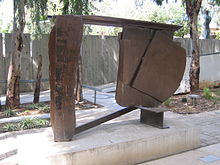
Welded sculptures have a relatively short history, dating back only to the 20th century. Before the development of current welding technology, sculptures made from metal were either cast or forged, and welding was primarily used in the construction industry.
The first welded sculptures were credited to the Russian artist Vladimir Tatlin, [1] who created his first piece of art in 1913. Tatlin was an important figure in the Russian Constructivist movement, which influenced the use of industrial materials in forms they had not yet been used in, mainly art.
In the 1920s and 1930s, more artists followed this path and the experimenting and artistic work of metalworking came to light. Some of the earliest founders in this practice included Julio Gonzalez, [2] and Alexander Calder. [3] Gonzalez was credited and noticed for his welded sculptures that were not only expressive in an abstract manner but functional as well. Calder’s pieces are among some of the most famous examples of welded sculptures, as they often hang from ceilings or trees. They were mobile structures that responded to air currents, moving in mesmerizing ways that were intriguing to the human eye.
The Catalan artist Julio González is credited as one of the most well known developers of welded sculpture. González came from a line of metalsmith workers; his grandfather was a goldsmith in Galicia, who established in the Catalan capital in the early 19th century. González's father, Concordio González, owned a workshop and as a young boy, González learned from him the techniques of gold, silver, and iron metalwork. He is associated with the Spanish circle of artists of Montmartre, including Pablo Gargallo, Juan Gris and Max Jacob. In 1918, he developed an interest in the artistic possibilities of welding, after learning the technique whilst working in the Renault Factory at Boulogne-Billancourt. This technique would subsequently become his principal contribution to sculpture, though during this period he also painted and —especially— created jewellery pieces. In 1920 he renewed his acquaintance with Pablo Picasso, for whom he later provided technical assistance in executing sculptures in iron, participating to Picasso's researches on analytic cubism. He also forged the infrastructures of Constantin Brâncuși's plasters. In the winter of 1927-28, he showed Picasso how to use oxy-fuel welding and cutting. When their friendship re-established itself, Picasso and González collaborated on a piece called Woman in the Garden between 1928-1930. From October 1928 till 1932, both men worked together. Influenced by Picasso, the fifty-year-old González changed his style, exchanging bronze for iron, and volumes for lines. González began to formalize a new visual language in sculpture that would change the course of his career. [4]
During the mid-20th century, welded sculptures continued to evolve, artists now have access to different materials, techniques, and technology that weren’t available to the early founders. In the 1950s and 1960s, large-scale industrial materials such as steel beams and large plates were utilized to construct monumental sculptures that were march larger than the ones in the past. Artists such as David Smith, [5] Anthony Caro, [6] and Richard Serra [7] were among the first group of artists to create these large-scale sculptures.
Today, welded sculptures are an established form of contemporary art, with artists continuously pushing the boundaries of what’s possible with modern materials and technology.

Welding was increasingly used in sculpture from the 1930s as new industrial processes such as arc welding were adapted to aesthetic purposes. [8] Welding techniques, including digital cutting, can be used to cut and join metal. Welded sculptures are sometimes site-specific. Artist Richard Hunt said "The idea of exploiting welding methods and the tensile strength of metals opened up many possibilities to me. This idea was actually linked to the increasing recognition among artists that an art which was representative of our own time ought to use materials and techniques that were at hand, whether it was new experiments using plastics, new kinds of paints, new kinds of surfaces in painting, or using materials developed during the war effort." [9] "
The following outline is provided as an overview of and topical guide to sculpture:

New materials in 20th-century art were introduced to art making from the very beginning of the century. The introduction of new materials and heretofore non-art materials helped drive change in art during the 20th century. Traditional materials and techniques were not necessarily displaced in the 20th century. Rather, they functioned alongside innovations that came with the 20th century. Such mainstays as oil-on-canvas painting, and sculpting in traditional materials continued right through the 20th century into the 21st century. Furthermore, even "traditional" materials were greatly expanded in the course of the 20th century. The number of pigments available to artists has increased both in quantity and quality, by most reckoning. New formulations for traditional materials especially the commercial availability of acrylic paint have become widely used, introducing initial issues over their stability and longevity.

Modern art includes artistic work produced during the period extending roughly from the 1860s to the 1970s, and denotes the styles and philosophies of the art produced during that era. The term is usually associated with art in which the traditions of the past have been thrown aside in a spirit of experimentation. Modern artists experimented with new ways of seeing and with fresh ideas about the nature of materials and functions of art. A tendency away from the narrative, which was characteristic for the traditional arts, toward abstraction is characteristic of much modern art. More recent artistic production is often called contemporary art or postmodern art.

The Museo Nacional Centro de Arte Reina Sofía is Spain's national museum of 20th-century art. The museum was officially inaugurated on September 10, 1992, and is named for Queen Sofía. It is located in Madrid, near the Atocha train and metro stations, at the southern end of the so-called Golden Triangle of Art.

Vladimir Yevgrafovich Tatlin was a Russian, Ukrainian, and Soviet painter, architect and stage-designer. Tatlin achieved fame as the architect who designed The Monument to the Third International, more commonly known as Tatlin's Tower, which he began in 1919. With Kazimir Malevich he was one of the two most important figures in the Soviet avant-garde art movement of the 1920s, and he later became an important artist in the constructivist movement.

In visual art, mixed media describes artwork in which more than one medium or material has been employed. Assemblages, collages, and sculpture are three common examples of art using different media. Materials used to create mixed media art include, but are not limited to, paint, cloth, paper, wood and found objects.
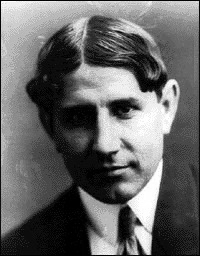
Pablo Emilio or Pau Emili Gargallo, known simply as Pau or Pablo Gargallo, was a Spanish sculptor and painter.

Kinetic art is art from any medium that contains movement perceivable by the viewer or that depends on motion for its effect. Canvas paintings that extend the viewer's perspective of the artwork and incorporate multidimensional movement are the earliest examples of kinetic art. More pertinently speaking, kinetic art is a term that today most often refers to three-dimensional sculptures and figures such as mobiles that move naturally or are machine operated. The moving parts are generally powered by wind, a motor or the observer. Kinetic art encompasses a wide variety of overlapping techniques and styles.
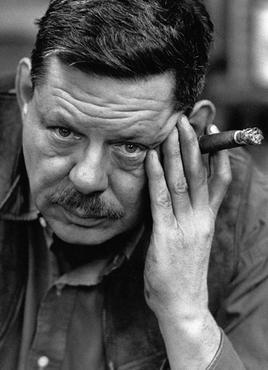
Roland David Smith was an American abstract expressionist sculptor and painter, best known for creating large steel abstract geometric sculptures.

Assemblage is an artistic form or medium usually created on a defined substrate that consists of three-dimensional elements projecting out of or from the substrate. It is similar to collage, a two-dimensional medium. It is part of the visual arts and it typically uses found objects, but is not limited to these materials.
Rosalind Epstein Krauss is an American art critic, art theorist and a professor at Columbia University in New York City. Krauss is known for her scholarship in 20th-century painting, sculpture and photography. As a critic and theorist she has published steadily since 1965 in Artforum,Art International and Art in America. She was associate editor of Artforum from 1971 to 1974 and has been editor of October, a journal of contemporary arts criticism and theory that she co-founded in 1976.

The Chicago Picasso is an untitled monumental sculpture by Pablo Picasso in Daley Plaza in Chicago, Illinois. The Picasso "precipitated an aesthetic shift in civic and urban planning, broadening the idea of public art beyond the commemorative."

Julio González i Pellicer, born in Barcelona, was a Spanish sculptor and painter who developed the expressive use of iron as a medium for modern sculpture. He was from a lineage of metalsmith workers and artists. His grandfather was a goldsmith worker and his father, Concordio González, a metalsmith worker who taught him the techniques of metalsmith in his childhood years. His mother, Pilar Pellicer Fenés, came from a long line of artists.

Pulitzer Arts Foundation is an art museum in St. Louis, Missouri, that presents special exhibitions and public programs. Known informally as the Pulitzer, the museum is located at 3716 Washington Boulevard in the Grand Center Arts District. The building is designed by the internationally renowned Japanese architect Tadao Ando. Admission to the museum is free.
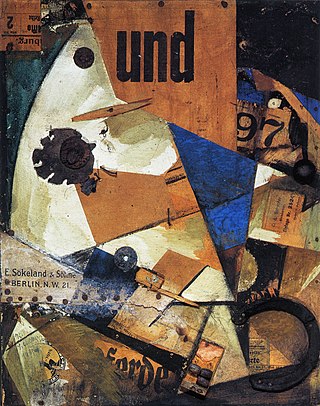
Collage is a technique of art creation, primarily used in the visual arts, but in music too, by which art results from an assemblage of different forms, thus creating a new whole.
Howard McCalebb is an American abstract sculptor.
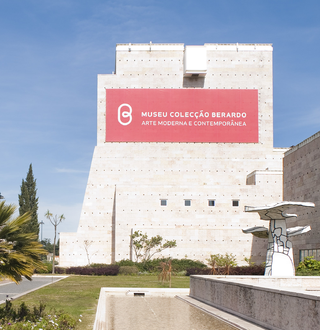
The Berardo Collection Museum was a museum of modern and contemporary art in Belém, a district of Lisbon, Portugal. It was replaced by the Conteporary Art Museum - Centro Cultural de Belém in January 2023.
Timelines of inventions display the development and progression of art, design, architecture, music and literature.

Modern sculpture is generally considered to have begun with the work of Auguste Rodin, who is seen as the progenitor of modern sculpture. While Rodin did not set out to rebel against the past, he created a new way of building his works. He "dissolved the hard outline of contemporary Neo-Greek academicism, and thereby created a vital synthesis of opacity and transparency, volume and void". Along with a few other artists in the late 19th century who experimented with new artistic visions in sculpture like Edgar Degas and Paul Gauguin, Rodin invented a radical new approach in the creation of sculpture. Modern sculpture, along with all modern art, "arose as part of Western society's attempt to come to terms with the urban, industrial and secular society that emerged during the nineteenth century".
Born in South Africa, Michael Edward Bolus was an artist and teacher who settled in England in 1957 and studied at St Martin's School of Art from 1958 to 1962, studying under Anthony Caro. After a brief period living in Cape Town he returned to London in 1964 to begin a teaching post at St Martin's and the Central School of Art and Design. Bolus had his first UK solo exhibition at Waddington Galleries in 1968, which has exhibited a number of his sculptures since then.